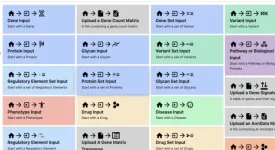(Press-News.org)
Solar energy is one of the most promising solutions for reducing our dependence on fossil fuels. But making solar panels more efficient is a constant challenge. Perovskite solar cells (PSCs) have been a game-changer, offering rapid improvements in efficiency and potential for low-cost manufacturing. However, they still suffer from energy losses and operational stability issues.
The challenge with wide-bandgap perovskites
Perovskite solar cells, particularly those used in tandem configurations, rely on wide-bandgap (WBG) materials—semiconductors that absorb higher-energy ("bluer") light while letting lower-energy (redder) light pass through—to maximize efficiency. However, wide-bandgap perovskite formulations often suffer from phase segregation, where different components separate over time, which causes a decline in performance.
One solution is to add rubidium (Rb) to stabilize WBG materials, but there’s a catch: Rb tends to form unwanted secondary phases, which reduces its effectiveness in stabilizing the perovskite structure.
The EPFL solution: strain to the rescue
Scientists led by Lukas Pfeifer and Likai Zheng in the group of Michael Grätzel at EPFL have now found a way to force Rb to stay where it’s needed. By utilizing "lattice strain" of the perovskite film, they managed to incorporate Rb ions into the structure, which prevented the unwanted phase segregation. This novel approach not only stabilizes the WBG material but also improves its energy efficiency by minimizing non-radiative recombination—a key culprit in energy loss.
The researchers used lattice strain—a controlled distortion in the atomic structure—to keep Rb locked into the perovskite lattice. They did this by fine-tuning the chemical composition and precisely adjusting the heating and cooling process. Rapid heating followed by controlled cooling induced strain, preventing Rb from forming unwanted secondary phases and ensuring it stayed integrated within the structure.
Verifying and fine-tuning the approach
To confirm and understand this effect, the team used X-ray diffraction to analyze structural changes, solid-state nuclear magnetic resonance to track the atomic placement of Rb, and computational modeling to simulate how the atoms interact under different conditions. These techniques provided a detailed picture of how strain stabilized Rb incorporation.
Besides lattice strain, they also found that introducing chloride ions is key to stabilize the lattice by compensating for the size differences between the incorporated elements. This ensured a more uniform distribution of ions, reducing defects and improving overall material stability.
The result? A more uniform material with fewer defects and a more stable electronic structure. The new perovskite composition, enhanced with strain-stabilized Rb, achieved an open-circuit voltage of 1.30 V—an impressive 93.5% of its theoretical limit. This represents one of the lowest energy losses ever recorded in WBG perovskites. Moreover, the modified material showed improved photoluminescence quantum yield (PLQY), indicating that sunlight was being more efficiently converted into electricity.
Impact on renewable energy
Reducing energy loss in perovskite solar cells could lead to more efficient and cost-effective solar panels. This is especially important for tandem solar cells, where perovskites are paired with silicon to maximize efficiency.
The findings also have implications beyond solar panels—perovskites are being explored for LEDs, sensors, and other optoelectronic applications. By stabilizing WBG perovskites, the EPFL research could help accelerate the commercialization of these technologies.
Other contributors
EPFL Laboratory of Magnetic Resonance
EPFL X-Ray Diffraction and Surface Analytics Platform
EPFL Crystal Growth Facility
EPFL Laboratory of Computational Chemistry and Biochemistry
Nanjing University of Aeronautics and Astronautics
National University of Singapore
Politecnico di Milano
Reference
Likai Zheng, Mingyang Wei, Felix T. Eickemeyer, Jing Gao, Bin Huang, Ummugulsum Gunes, Pascal Schouwink, David Wenhua Bi, Virginia Carnevali, Mounir Mensi, Francesco Biasoni, Yuxuan Zhang, Lorenzo Agosta, Vladislav Slama, Nikolaos Lempesis, Michael A. Hope, Shaik M. Zakeeruddin, Lyndon Emsley, Ursula Rothlisberger, Lukas Pfeifer, Yimin Xuan, Michael Grätzel. Strain-induced rubidium incorporation into wide bandgap perovskites reduces photovoltage loss. Science 04 April 2025. DOI: 10.1126/science.adt3417
END
How GPS helps older drivers stay on the roads
Peer reviewed – observational study - humans
Sat Nav systems help keep older drivers on the roads for longer, according to new research from the University of East Anglia.
A new study published today reveals that over 65s with a poorer sense of direction rely more on help from GPS navigation systems such as Sat Nav or smartphone maps.
Those using GPS tended to drive more frequently - suggesting that the technology helps older people maintain driving independence.
Senior author Prof Michael Hornberger, from UEA’s Norwich Medical School, said: “Driving is usually the preferred mode of transport among ...
Scientists have discovered a new mechanism that acts via an immune cell and points toward a different way of treating chronic pain.
Female hormones can suppress pain by making immune cells near the spinal cord produce opioids, a new study from researchers at UC San Francisco has found. This stops pain signals before they get to the brain.
The discovery could help with developing new treatments for chronic pain. It may also explain why some painkillers work better for women than men and why postmenopausal ...
Engineers at a University of Bristol spin-out company have created a new technology that can move cells without touching them, enabling critical tasks that currently require large pieces of lab equipment to be carried out on a benchtop device.
The invention could accelerate the discovery of new medicines and unlock personalised medicine screening in clinics.
The groundbreaking concept was unveiled for the first time today in an article in Science published by Dr Luke Cox, where he describes his journey from University of Bristol ...
University of Queensland scientists have helped to construct a detailed timeline for bacterial evolution, suggesting some bacteria used oxygen long before evolving the ability to produce it through photosynthesis.
The multinational collaboration – led by researchers from the Okinawa Institute of Science and Technology, the University of Bristol, Queensland University of Technology and UQ – focused on how microorganisms responded to the Great Oxygenation Event (GOE) about 2.33 billion years ago, which changed ...
A team of researchers led by Dr. KIM V. Narry, director of the Center for RNA Research at the Institute for Basic Science (IBS), has uncovered a key cellular mechanism that affects the function of mRNA vaccines and therapeutics. Their study, recently published in Science, provides the first comprehensive understanding of how mRNA vaccines are delivered, processed, and degraded within cells—a breakthrough that could pave the way for more effective vaccines and RNA-based treatments.
Messenger RNA (mRNA) is the genetic blueprint that tells cells how to produce proteins. It plays a vital role in mRNA vaccines, such as those used for COVID-19, and is also a promising ...
Our environment is changing rapidly, largely as a result of human activities, leading to a significant decline in biodiversity. According to researchers from the University of Victoria and the Max Planck Institute for Evolutionary Anthropology, this decline does not only affect animal life, but also our understanding of their behavior, including tool use.
"Cultural behaviors range from the songs of whales to the tool use of primates," says Ammie Kalan of the University of Victoria. "These adaptations to environmental change not only benefit the animals, but also provide important insights into the origins of behavior and learning across species. However, shrinking ...
GPS tech may empower older adults to be more adventurous on the road, according to a study published April 3, 2025 in the open-access journal PLOS Digital Health by Sol Morrissey from the University of East Anglia and colleagues.
Driving is older adults’ preferred transportation method, but age-related cognitive decline can limit time spent behind the wheel. Empowering older adults to be more mobile drivers (that is, driving more frequently and for longer distances) is critical to boosting physical, social and cognitive wellness. Electronic navigation systems ...
Antibiotic resistance tends to stabilize over time, according to a study published April 3, 2025 in the open-access journal PLOS Pathogens by Sonja Lehtinen from the University of Lausanne, Switzerland, and colleagues.
Antibiotic resistance is a major public health concern, contributing to an estimated 5 million deaths per year. Understanding long-term resistance patterns could help public health researchers to monitor and characterize drug resistance as well as inform the impact of interventions on resistance.
In this study, researchers analyzed drug resistance in more than 3 million bacterial samples collected across ...
Insects are the dominant form of animal life on our planet, providing humans and wildlife with pollination, food, and recycling services but, despite concerns about population declines, little is known about how 99% of species globally are faring.
A new approach is needed to better monitor species and protect them from the impacts of climate and land use change, pollution and invasive non-native species as soon as possible, according to a study led by the UK Centre for Ecology & Hydrology (UKCEH) and ZSL (Zoological Society of London).
The researchers, whose work has been ...
New York, NY [April 3, 2025]— A powerful new software platform called the Playbook Workflow Builder is set to transform biomedical research by allowing scientists to conduct complex and customized data analyses without advanced programming skills. An article that describes the new platform was published in the April 3 online issue of the journal PLOS Computational Biology.
Developed by a multi-institutional team that was led by Icahn School of Medicine at Mount Sinai investigators as part of the National Institutes of Health Common Fund Data ...




